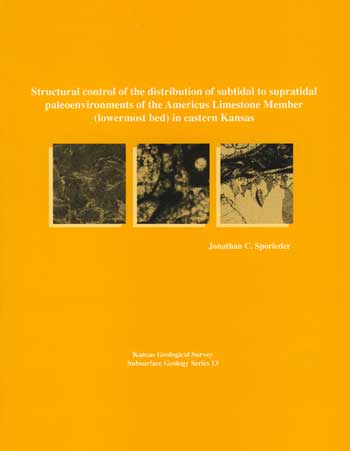Structural control of the distribution of subtidal to supratidal paleoenvironments of the Americus Limestone Member (lowermost bed) in eastern Kansas
DOI:
https://doi.org/10.17161/kgsbulletin.no..23615Abstract
The Americus Limestone Member of the Foraker Limestone (Wolfcampian) in Kansas formed during transgression of an epeiric sea. Lateral differentiation of paleoenvironments resulted from differences in paleotopography of the seafloor, which overlies buried anticlinal structures. Eight paleoenvironmental stages of transgression are recognized in a typical vertical succession of lithofacies: (1) formation of limestones and shales under hypersaline, brackish, and subaerial conditions and deposition of lime sand under freshwater conditions preceding inundation and deposition of the Americus limestone; (2) deposition of a thin layer of shale during initial inundation; (3) transition from brackish to restricted marine paleoenvironments characterized by development of peloid-alga boundstones (stromatolites); (4) restricted marine paleoenvironments characterized by encrustations of Spirorbis-foraminifer-alga boundstones; (5) deposition of carbonates under conditions that were transitional from restricted marine to nearly normal marine, characterized by abundant Calcivertella foraminifers, ostracodes, and gastropods, and foraminifer-alga boundstone; (6) deposition of carbonates under more nearly normal to normal marine conditions characterized by grapestones, ooids, echinoids, crinoids, bryozoans, brachiopods, sponge spicules, pectinoid and myalinid bivalves, and a variety of foraminifers; (7) turbid marine conditions corresponding to the deposition of shale with some crinoids, brachiopods, and bivalves; and (8) formation of the upper limestones of the Americus under normal marine conditions, characterized by abundant fusulinids, crinoids, brachiopods, bryozoans, and bellerophontid gastropods. The lower limestone of the Americus indicates lateral differentiation of paleoenvironments with more nearly normal marine conditions toward the south. Differences in paleotopography of the seafloor resulted in high areas characterized by supratidal to relatively high-energy shallow- water paleoenvironments and low areas characterized by relatively low-energy deeper-water paleoenvironments. Paleotopographically high areas are generally characterized by packstones and grainstones, thin intervals of overlying shale, discrete plates of Spirorbis-foraminifer-alga boundstone, laterally discontinuous stromatolites with extensive fenestrae, rip-up clasts of boundstone, thick stromatolitic layers with extensive encrustations, high-domed stromatolites, and Globivalvulina foraminifers and pectinoid and myalinid bivalves. Paleotopographically low areas are characterized by lime mudstones and wackestones; thick intervals of overlying shale; and thin, flat-layered to low-domed stromatolites. Paleotopographically high areas of the ancient seafloor coincide with such structural features as the Nemaha anticline, the Alma-Davis Ranch anticline, the Bourbon arch, and the Beaumont anticline, indicating that these structural features were ultimately responsible for lateral differentiation of paleoenvironments either by differential compaction or by subtle tectonic movement. It should be possible to use these relationships in similar strata to locate potential anticlinal structures.

Downloads
Published
Issue
Section
License
Copyright (c) 2025 Jonathan C. Sporleder

This work is licensed under a Creative Commons Attribution-NonCommercial 4.0 International License.
